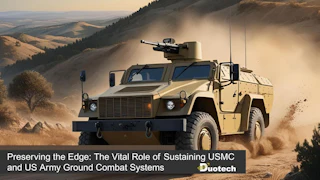Preserving the Edge: The Vital Role of Sustaining USMC and US Army Ground Combat Systems

However, behind every successful ground operation is a silent but critical challenge: sustainment. In particular, the sustainment of legacy combat platforms—many of which have been in service for decades—is a growing concern. And it’s not just about keeping the engines running. It’s about sustaining the complex electronics, sensors, and subsystems that allow these platforms to operate effectively in modern battlespaces.
Backbone of the Battlefield: Key USMC and Army Platforms
USMC Ground Combat Systems
Light Armored Vehicle (LAV): A cornerstone of the Marine Corps’ expeditionary operations, the LAV provides speed and mobility across rugged terrain while offering reconnaissance and light firepower capabilities.
Amphibious Assault Vehicle (AAV): Serving since the 1970s, the AAV enables critical ship-to-shore movement during amphibious operations, proving essential in both combat and humanitarian missions.
U.S. Army Ground Combat Systems
M2/M3 Bradley Infantry Fighting Vehicle: Renowned for its blend of mobility, protection, and firepower, the Bradley remains a core vehicle in infantry operations, though its age presents sustainment challenges.
Stryker: A highly adaptable, wheeled combat vehicle capable of fulfilling a variety of roles from troop transport to mobile anti-tank missions.
M1 Abrams: As the gold standard of modern tanks, the Abrams continues to evolve. However, much of its internal systems still rely on legacy components and designs.
Ground-Based RADARs and Defense Systems
Supporting everything from missile defense to early warning systems, these platforms are increasingly software- and electronics-heavy—further raising the stakes for sustainment and long-term performance.
Legacy Systems, Modern Problems
While these platforms remain mission-critical, many are reaching or exceeding their intended service lives. The result?
Component Obsolescence: Original equipment manufacturers (OEMs) have shifted focus or exited the market. Replacement parts are scarce or no longer in production.
Increased Downtime: Systems sit idle due to unavailable electronics modules or faulty subsystems.
Limited Documentation: Many of these systems were designed long before today's digital design and documentation standards. Engineers often work with little to no legacy data.
The Electronics Sustainment Challenge
Combat platforms today are not just steel and armor—they're packed with electronics that control everything from fire systems to navigation to communications. Sustaining these systems introduces an entirely new level of complexity:
Microprocessors and FPGAs often go obsolete within a decade.
Custom-built subsystems may have no available replacements or documentation.
Testing and diagnostics are time-consuming and error-prone without automated solutions.
This isn’t just a technical hurdle—it’s a readiness issue. Without fully operational electronics, the entire system fails.
How Duotech Keeps Combat Platforms Mission-Ready
At Duotech, we’ve made it our mission to solve the toughest sustainment challenges with speed, precision, and reliability. We specialize in keeping ground combat systems in the fight—no matter how old or complex their electronics may be.
Here’s how:
Reverse Engineering: When documentation doesn’t exist, Duotech steps in. Our team can analyze, replicate, and re-engineer legacy electronics and modules with minimal upfront data.
Repair and Remanufacture: From circuit boards to power supplies, we restore and rebuild electronic components quickly and cost-effectively.
Custom Automated Test Equipment (ATE) Development: Duotech delivers scalable, configurable ATE solutions—even when original test sets are no longer available.
Rapid Turnaround: We know readiness can’t wait. Duotech delivers solutions in weeks—not months.
Readiness is the Real Superpower
Modern combat platforms are engineering marvels, but their effectiveness comes down to one question: Can they perform when it matters most?
The U.S. Marine Corps and Army depend on decades-old platforms that must evolve with today’s demands. Sustainment isn’t just a technical need—it’s a national defense imperative.
At Duotech, we ensure that aging systems stay fully mission-capable, by bridging the gap between yesterday’s designs and today’s demands. Whether it's through reverse engineering, repair, or automated test solutions, we help warfighters move forward—confident their equipment will keep up.
Because in the end, readiness isn’t optional—it’s the foundation of victory.
Let’s Talk Mission Readiness
Ready to learn more about how Duotech’s forward-deployed test and repair capabilities can keep your platforms combat-ready?
👉 Contact us today at business_development@duotechservices.com to discuss your mission requirements and see how we can deliver solutions faster—with less data and greater confidence.